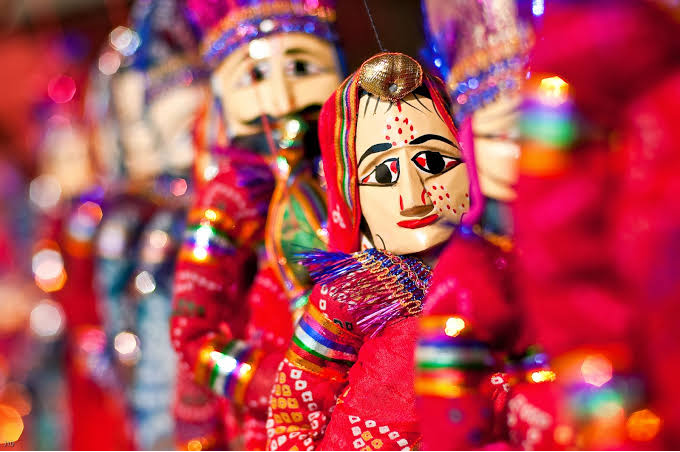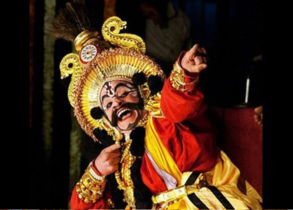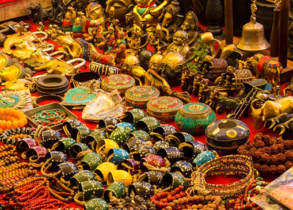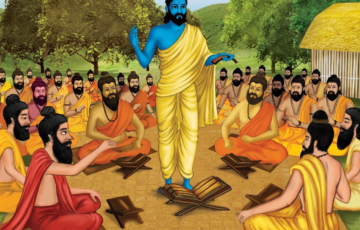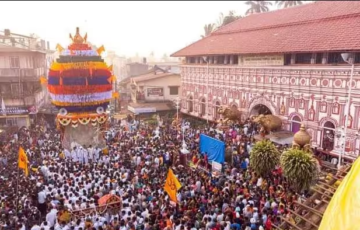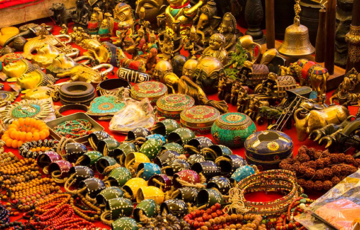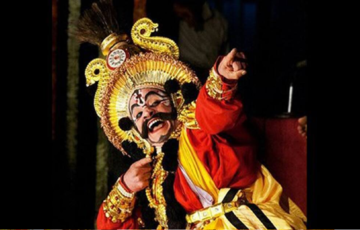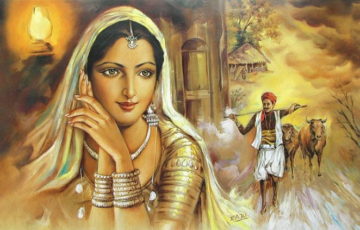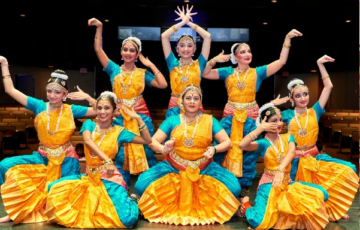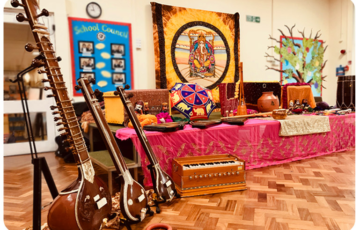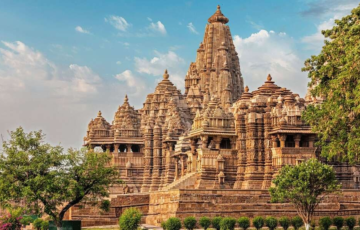INDIAN PUPPETRY
Puppetry
- A puppet stands as one of humanity’s most remarkable and ingenious inventions. Puppetry, a form of narrative theatre, resides at the crossroads of bardic storytelling and theatrical performances.
- Puppet shows incorporate live music, narration, and dance-inspired gestures. Throughout history, puppetry has held a significant place in traditional entertainment, drawing inspiration from epics and legends, much like traditional theatre.
- Puppets crafted in various regions of the country bear their distinct identities, mirroring regional styles of painting and sculpture.
Origin of Indian Puppetry
- The inception of Indian puppetry dates back to around 500 BC, as evident from references to marionette theatre. Archaeological discoveries at Harappa and Mohenjo-Daro have revealed puppets with sockets, attesting to the popularity of puppetry during that period.
- In the Sangham age, both the Silappadikaram, composed in the first and second century BC, and the Mahabharata make references to puppetry. Beyond its role as an artistic medium, puppetry holds philosophical significance in Indian culture. The Bhagavad Geeta draws a parallel between God and a puppeteer manipulating the universe through the three cords: Satta, Raja, and Tama.
- India boasts a diverse array of puppetry traditions, each distinguished by its unique puppet styles. Inspired by folklore, mythology, and local legends, puppetry has evolved into a distinctive form of artistic expression, seamlessly integrating with other art forms such as painting, sculpture, music, dance, and theatre.
- Despite its rich history, this creative genre has witnessed a gradual decline in recent years, attributed to a lack of dedicated enthusiasts and financial uncertainties.
Is Indian Puppetry a Dying Art Form?
- The emergence of popular electronic media and a growing preference for Western modes of entertainment have posed challenges to the survival of puppetry in India. Limited patronage, along with constraints in script, improvisation, and lighting, has led to a decline in its popularity.
- However, categorizing puppetry as a dying art form may not be entirely accurate. Modernized techniques of presentation have been incorporated, blending ancient storytelling with contemporary approaches. Organizations like the ‘Dhaatu Puppetry Fest,’ founded by Anupama Hoskere, play a pivotal role in reviving and promoting traditional puppetry. Anupama Hoskere’s contributions were recognized with the Central Sangeet Natak Akademi Puraskar for Puppetry. The international puppet festivals organized by Dhaatu have successfully reintroduced many people to this captivating art form, fostering its influence among both rural and urban populations.
Types of Puppetry
A variety of puppets exists, distinguished by the materials used, their form, and intended function. Puppets can range from highly intricate to remarkably simple in their construction. India encompasses almost all types of puppets, with each region contributing to their identity through unique styles of painting and sculpture.
These different types can be broadly categorized into four basic groups:
- Glove Puppets
- String Puppets
- Rod Puppets
- Shadow Puppets
Glove puppets
- Glove puppets are primarily found in Uttar Pradesh, Odisha, West Bengal, and Kerala. Worn on the hand, puppeteers manipulate the heads and arms of these puppets using their fingers.
- Also known as sleeve, hand, or palm puppets, they feature heads made of materials like paper mache, cloth, or wood, with two arms emerging just below the neck. Manipulation involves inserting the first finger into the head and using the middle finger and thumb as the puppet’s arms. The coordinated movement of these three fingers brings the glove puppet to life.
- In Uttar Pradesh, glove puppet plays often delve into social themes. In Odisha, the plays revolve around the tales of Radha and Krishna. Puppeteers in Odisha often play the dholak with one hand while manipulating the puppet with the other, creating a well-synchronized and dramatic performance.
- Kerala has its traditional glove puppet play called Pavakoothu, which emerged in the 18th century under the influence of Kathakali, the renowned classical dance-drama of Kerala. Pavakoothu features puppets with heads and arms carved from wood, joined together with thick cloth.
- The puppets are adorned with painted faces, gilded tin pieces, and peacock feathers, reminiscent of Kathakali actors. Puppet heights range from one to two feet, and musical instruments such as Chenda, Chengiloa, Ilathalam, and Shankha (conch) are used during performances. The themes of glove puppet plays in Kerala often draw inspiration from episodes in the Ramayana or the Mahabharata.
String Puppets
String puppetry places significant emphasis on the puppeteer’s manipulative skill. India boasts a rich and ancient tradition of string puppets or marionettes, known for their greater flexibility and articulation. This form of puppetry has thrived in regions such as Rajasthan, Odisha, Karnataka, and Tamil Nadu.
Key features of string puppets include:
- The puppets are typically miniature figures, measuring eight to nine inches, carved out of wood.
- Oil paint is used for the initial coloring of the wood, and additional facial features such as eyes, lips, and nose are added.
- Small wooden pipes form the limbs of the puppets, and the body is covered with a colorful miniature dress that is stitched.
- Miniature jewelry and accessories are attached to enhance the lifelike appearance.
- Strings are attached to small holes in the hands, head, and back of the body, controlled by the puppeteer.
Kathputli
Kathputli, as they are known in Rajasthan, are carved out of a single piece of wood, resembling large dolls dressed in colorful Rajasthani attire. Puppeteers manipulate them with two to five strings typically tied to their fingers.
features of Kathputli include:
- Costumes and headgears designed in the Rajasthani style.
- Puppetry performances are accompanied by a highly dramatized version of regional music.
- Distinct facial features, such as oval faces, large eyes, arched eyebrows, and large lips.
- These puppets wear long trailing skirts and lack legs.
Kundhei
In Odisha, these puppets are known as Kundhei. Crafted from lightweight wood and lacking legs, they wear long flowing skirts, sometimes influenced by the music of Odissi dance.
features of Kundhei puppets include:
- More joints, enhancing their versatility, articulation, and ease of manipulation.
- Puppeteers often use a triangular-shaped wooden prop to which strings are attached for manipulation.
- The costumes of Kundhei resemble those worn by actors in Jatra traditional theatre.
Gombeyatta
In Karnataka, these puppets are called Gombeyatta, styled and designed like characters from Yakshagana, the traditional theatre form of the region. Gombeyatta episodes typically draw inspiration from the Prasangas of Yakshagana plays.
Key features of Gombeyatta puppet figures and puppetry include:
- Highly stylized puppet figures with joints at the legs, shoulders, elbows, hips, and knees.
- Manipulated by five to seven strings tied to a prop.
- Some of the more intricate movements are coordinated by two to three puppeteers simultaneously.
- The accompanying music is dramatic, beautifully blending folk and classical elements.
Bommalattam
In Tamil Nadu, these puppets are known as Bommalattam, combining the techniques of both rod and string puppets. Made of wood, the strings for manipulation are tied to an iron ring worn by the puppeteer like a crown on their head. Some puppets have jointed arms and hands manipulated by rods.
features of Bommalattam puppetry include:
- The largest, heaviest, and most articulate of all traditional Indian marionettes.
- Puppets may reach a height of 4.5 feet, weighing about ten kilograms.
- Bommalattam theatre has elaborate preliminaries divided into four parts – Vinayak Puja, Komali, Amanattam, and Pusenkanattam.
Rod Puppets
Rod puppets, evolving from glove puppets, are typically larger and manipulated by rods from below. This puppetry style is predominantly practiced in West Bengal and Odisha.
Putul Nautch (West Bengal)
In West Bengal, this form is known as Putul Nautch. Crafted from wood, these puppets showcase various artistic styles specific to different regions. While the original human-sized rod puppets of the Nadia district are nearly extinct, the surviving Bengal rod puppets stand about 3 to 4 feet in height, donning costumes reminiscent of Jatra actors, a traditional theatre form in the state.
Key features of Bengal rod puppets include:
- Height ranging from 3 to 4 feet.
- Costumes resembling Jatra actors.
- Three joints, with heads supported by the main rod and hands attached to rods joined at the shoulders.
- Manipulation involves a bamboo hub tied to the puppeteer’s waist, supporting the rod holding the puppet.
- Puppeteers stand behind a head-high curtain, manipulating rods while dancing and moving in synchronization with the puppets.
- Puppeteers sing and deliver stylized prose dialogues, accompanied by a group of musicians playing drums, harmonium, and cymbals.
Odisha Style of Rod Puppetry
Traditional rod puppetry in Odisha differs in several aspects:
- Smaller puppets, typically measuring twelve to eighteen inches.
- Three joints, with hands tied to strings instead of rods, combining elements of rod and string puppets.
- Manipulation involves Odisha rod puppeteers squatting on the ground behind a screen.
- More operatic in verbal content, with infrequent use of impromptu prose dialogues; most dialogues are sung.
- Music blends folk tunes with classical Odissi tunes and begins with a short ritual orchestral preliminary called Stuti.
Yampuri (Bihar)
In Bihar, the traditional rod puppet is known as Yampuri, featuring unique characteristics:
- Crafted from wood.
- Unlike traditional rod puppets in West Bengal and Odisha, Yampuri puppets are in one piece and lack joints.
- Manipulation requires greater dexterity due to the absence of joints.
These distinctive features make Yampuri an intriguing and captivating form of traditional rod puppetry in Bihar.
Shadow Puppets
India presents the most diverse array of shadow puppets, featuring various types and styles. Crafted from treated leather to achieve translucency, these flat figures are positioned against a screen with a powerful light source behind them, creating silhouettes or vibrant shadows for the seated viewers. This tradition of shadow puppets thrives in states like Odisha, Kerala, Andhra Pradesh, Karnataka, Maharashtra, and Tamil Nadu.
Togalu Gombeyatta (Karnataka)
In Karnataka, this form is acknowledged as Togalu Gombeyatta, translating to “a play of leather dolls” in Kannada. Key features include:
- Generally small in size.
- Varied puppet sizes based on social status, with larger ones for kings and religious characters and smaller ones for common people or servants.
Tholu Bommalata (Andhra Pradesh)
In Andhra Pradesh, shadow theatre is known as Tholu Bommalata, featuring a musically classic background and focusing on mythological and devotional tales. It stands out with the following characteristics:
- Large-sized puppets with jointed waist, shoulders, elbows, and knees.
- Puppets colored on both sides, creating colored shadows on the screen.
- Dominantly influenced by the classical music of the region.
- Themes drawn from the Ramayana, Mahabharata, and Puranas.
Ravanachhaya (Odisha)
In Odisha, it is identified as Ravanachhaya, and despite smaller puppet size, it is theatrically exciting with unique features:
- Puppets are in one piece and lack joints.
- Uncolored puppets that cast opaque shadows on the screen.
- Manipulation requires great dexterity due to the absence of joints.
- Crafted from deer skin, these puppets take bold and dramatic poses.
- Use of non-human puppets such as trees and animals, along with various props like trees, mountains, chariots, etc.
The Ravanachhaya shadow theatre is particularly renowned for its sensitivity and lyricism, making it a distinct and captivating form of traditional puppetry.

